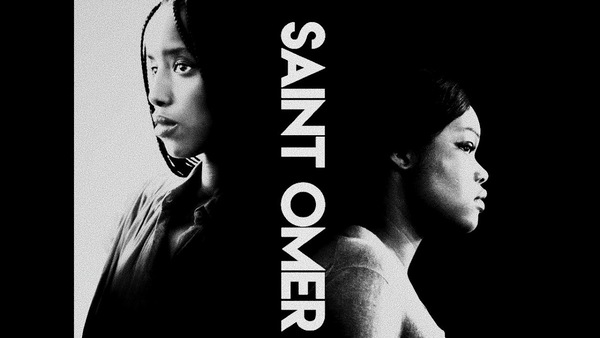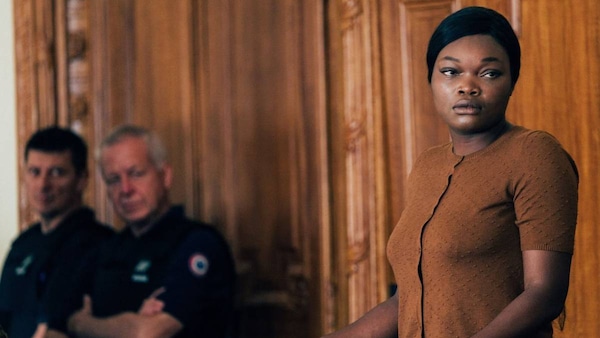Saint Omer: Motherhood, Identity, Trauma, In Black & White
Saint Omer takes its title from a town in Northern France where a murder trial caused quite a media stir in 2016. Prahlad Srihari reviews.

Last Updated: 12.46 PM, Apr 26, 2023
BEFORE WE COULD CRAWL, walk, cycle and drive, we were wriggling sea creatures, says evolutionary biology. It’s not too different from how we first experienced the world, wriggling in the amniotic sea of our mother’s wombs. The sea is inexhaustible, life-giving and nurturing. So is motherhood. Both natural force fields of strength, beauty, generosity, resilience and anger. In French, the two are linked by homophony: la mer (sea) and la mère (mother). French filmmaker Alice Diop consciously evokes this slippage between the words in service of a syllogism that consecrates both in her first non-documentary feature Saint Omer. Through the stories of parallel mother figures, the film raises critical questions about the scars left by inherited trauma, about the xenophobic after-effects of colonialism, and about being black in white spaces.
Saint Omer takes its title from a town in Northern France where a murder trial caused quite a media stir in 2016. Three years earlier, a French-Senegalese woman named Fabienne Kabou had walked to the beach in Berck-sur-Mer, nursed her 15-month-old daughter and left the child to drown. When the trial began, Kabou claimed to have been under the influence of witchcraft. Among the public seated in the gallery was Diop, who watched the court proceedings in curiosity as to what would drive a woman not unlike herself — a well-educated daughter of Senegalese parents — to kill a child and then blame it on witchcraft. Diop stages a fictionalised courtroom drama by recasting actual transcripts from the trial. Standing in for Kabou is Laurence Coly (Guslagie Malanda) who faces the impossible task of explaining the motivation for an inexplicable crime she has already confessed to. Why she did it is a mystery to herself. On the first day of court, when the judge (Valérie Dréville) questions her, she replies in earnest expectation, “I don’t know why. I hope this trial will give me the answer”. Standing in for Diop is Rama (Kayije Kagame), a pregnant novelist hoping to position Laurence as a modern Medea figure in her next book.

As the trial unfolds, we come to learn how Laurence began to feel more and more invisible on moving to Paris. Switching her field of study from law to philosophy estranged her from her parents. Without their financial support, she was forced to move in with her much older partner Luc Dumontet (Xavier Maly), a married white man who kept her secluded, neglected and hidden away in his studio. On becoming pregnant, she withdrew from the world. On giving birth, she slipped into postnatal depression and withdrew further. Sheer exhaustion brought on hallucinations. By the time the tipping point arrived, she had turned into a phantom. Her unspeakable crime was thus an act of resistance born out of desperation, as it was for Medea. Euripides’ conception of an isolated, homeless, stateless mythical figure speaks to the struggles of mothers, migrants and all the marginalised facing systemic disempowerment and fighting for personal agency. Diop’s conception is as rooted in reality as it is in myth. In Laurence’s desperate act, we see a young woman neglected to the point of invisibility, a mother without a safety net pushed to her limits, and a migrant fighting a near-impossible battle to gain a foothold overseas.
It’s not how the prosecution sees Laurence of course. A white university lecturer wonders why she chose to focus her research on Austrian philosopher Ludwig Wittgenstein, instead of a subject “closer to her own culture”. Prosecutors pick her apart with statements tainted by condescension and pile on the racial micro-aggressions. Luc accepts no blame for the part he played in Laurence’s downward spiral. The entire system is stacked against her. For Laurence’s counsellors, her claims about a family curse and witchcraft become nothing else but grounds for an insanity defence plea.
The more Rama listens to Laurence’s testimony, the harder it becomes to maintain a professional distance. Commonalities emerge: their Senegalese roots; their white French companions; their anxiety over cultural displacement; their strained relationship with their mothers; and their shared anxieties over becoming mothers themselves. Painful memories from Rama’s childhood begin to encroach on the frayed edges of Laurence’s confessions amidst the trial. The almost spiritual bond between the two is teased in the opening scene. Laurence carries her child wrapped in a bundle and walks to the sea as if the waves are calling to her — when the scene cuts to Rama waking up and crying out for her mother. Laurence’s worst night becomes Rama’s nightmare. Days into the trial, Rama confesses to her partner in bed, “I’m afraid I will be like her”. We assume she means Laurence. When he asks, “Like who?”, she clarifies, “Like my mother”. A brief pause before the response suggests it could be both. It’s partly this frightening thought which causes her to break down in tears in a scene at the end, when Laurence gives her a disquieting half-smile after the two make eye contact.

Days before she leaves for the trial, while giving a lecture on Marguerite Duras’s screenplay of Hiroshima Mon Amour to students at a university, Rama explains how Duras “used the power of her narrative to sublimate reality”. The same explains Diop’s own approach to the story. She refrains from the theatrical spectacle of courtroom dramas and the hasty judgements of true crime for a more thoughtful investigation into how migrant mothers negotiate intersecting inequalities of gender, ethnicity and class. As viewers, our own biases are called into question. Cuts don’t arrive summarily to offer reprieve. The camera lingers on Malanda’s stoic face in long takes that resist the other-ing gaze of white authorities keen to rob Laurence of her humanity by painting her as a monster. Justice is easier preached than served in the courtroom, a veritable bastion of colonialism.
For the colonisers, language was instrumental in establishing supremacy over the colonised. By encouraging and rewarding those who speak it is how they continue to maintain their position of power. On migrating, the once-colonised aspire to the position of their once-coloniser by speaking the language fluently. A lack of fluency becomes a barrier to assimilation. At the same time, always speaking the coloniser’s tongue can end up alienating people from their own heritage. Laurence describes to the court how her parents insisted she speak French, not Wolof, back home in Dakar to ease her transition in France. The clarity and precision of her diction are matters of great pride for her mother Odile (Salimata Kamate). Notwithstanding the crime, Odile remains somewhat upbeat that all the newspapers are writing about her daughter. When she expresses her dismay over Laurence speaking out of turn, it attests to a generational penchant for suffering internally. Speaking “correct” French without an accent still ends up working against Laurence. For the same language used to proclaim justice is also used to justify discrimination. As a study of maternal ambivalence, a portrait of cultural erasure, and an indictment of post-colonial attitudes, Saint Omer is as hauntingly powerful as they come.
Saint Omer was among the titles screened at the Bangalore International Film Festival 2023 last month.
